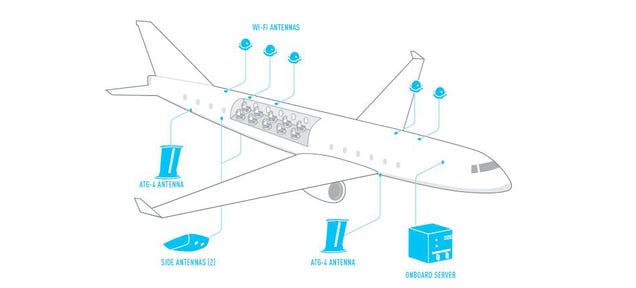Airplanes use many of the same towers and satellites that deliver data to our smartphones, connecting to towers on the ground, or to satellites, or to both.
Air-to-ground (ATG) connectivity is ostensibly faster, since the towers on the ground are closer. This is what Gogo primarily uses. Gogo is the company that linked to those AirCell phones you used to see in the backs of headrests. Now, it powers wifi on a majority of the major US airlines.
If you’re buying wifi on an airplane these days, there’s a good chance you’re buying it from Gogo, though it isn’t the only provider. Some airlines, like JetBlue and Southwest, manage proprietary wifi systems using other technology. Gogo is also increasingly using a newer technology called ATG-4 that takes advantage of multiple antennas—four of them, arranged strategically along the fuselage—to grab signals and offer faster speeds.
Chart via Gogo
The Gear That Makes It Possible
They may be using the same equipment that people on the ground use, but airplanes need to hold onto network signals as they zip through the air at around 550 miles per hour.
Because an airplane is moving through the stratosphere at such high speeds, the antenna must constantly maintain a connection to any given tower or satellite. It doesn’t help that the satellites themselves are orbiting the Earth at 18,000 miles per hour. At a certain point, the antenna will have to find a new tower or satellite. Some antennas do this with motors that pan and tilt to catch a signal.
Many companies are trying to come up with better solutions. One obvious solution is to build a better antenna with fewer moving parts that can sit right on top of the fuselage without a bulky bulge. Ideally, the antennas won’t move at all. Instead, these next-gen systems take advantage of beamforming, or spatial filtering technology, that uses multiple antennas to create a more focused and precise signal. Some of the best wifi routers for your home offer beamforming signal processing technology, too!

No comments:
Post a Comment